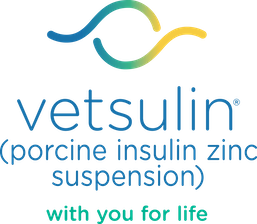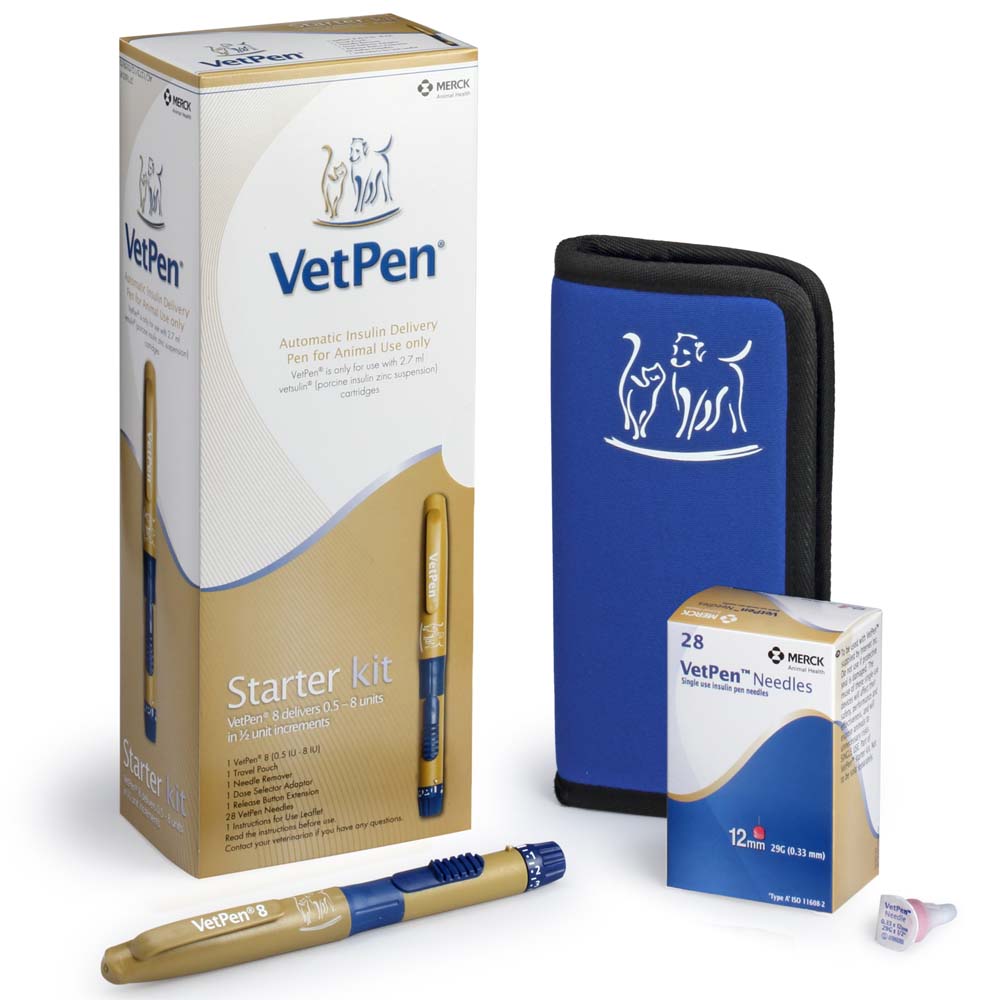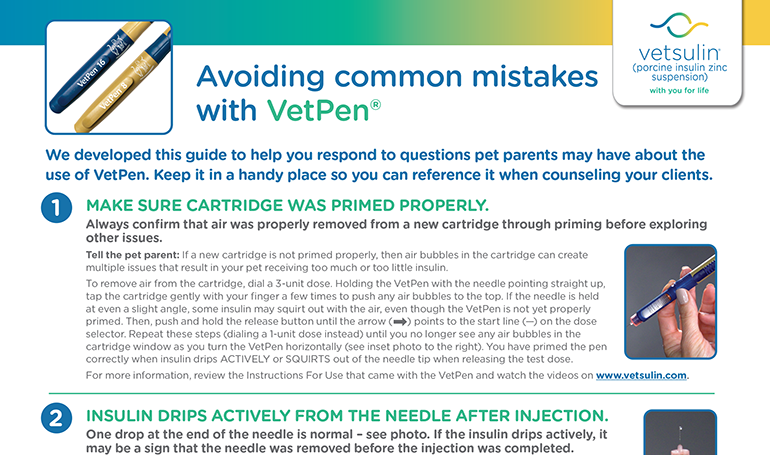

Frequently Asked Questions
General Questions about VetPen®

What makes VetPen® unique?
While insulin pens have been commonly used in the management of human diabetes for some time, VetPen is the first such device designed exclusively for use in cats and dogs.
Using the same technology found in human insulin pens, VetPen: Is more convenient and easier to use than insulin vials and syringes. Delivers an accurate dose consistently over time, with less chance of error provides a better fit to pet owners’ lifestyles—takes fewer steps to prepare doses once primed (air removed from cartridge) and can be used anywhere.
Is VetPen difficult to use?
VetPen is ergonomically designed for easy handling and dosing. Additional adaptors are provided to further assist pet owners with visual or manual dexterity issues.
In a 3-week study, close to 97% of pet owners reported that VetPen was easy to use overall.3 And more than 97% reported being able to learn how to use VetPen.12,13
Is VetPen more accurate than using an insulin syringe?
Yes. In a laboratory study, VetPen was shown to be consistently more accurate than syringes for low doses. Even when drawn up by trained lab technicians, study results showed that U-40 syringes delivered at least 20%-25% more insulin than needed for a 1-unit dose.11 Unlike syringes, VetPen provides a precise and accurate dose every time, without relying on the user to draw up an accurate dose.
Can VetPen be used with different insulins?
No. VetPen must be used with specially designed 3 mL cartridges containing 2.7 mL of 40 IU/mL concentration of Vetsulin, the world’s most trusted veterinary insulin, proven safe and effective for more than 25 years in hundreds of thousands of pets with diabetes.* To avoid damaging VetPen and dosing errors, cartridges containing other insulin should not be used with VetPen.
* Vetsulin is known as Caninsulin outside the US.
Using VetPen®
How does selecting a dose with VetPen differ from drawing up a dose with a syringe?
While the overall injection process is similar, VetPen allows you to select doses more accurately. With just the turn of a dial, you can select a customized dose of insulin down to 0.5 units. And, with a push of the release button, the VetPen’s internal mechanism works to deliver the precise dose each and every time.
How do I know when the injection is complete?
To make sure the pet’s dose is injected precisely and accurately, you need to hold down the release button until the arrow (▶) points to the start line (—) on the dose selector. Then, wait at least 5 seconds before removing the needle from the skin. This allows for VetPen’s internal mechanism to optimally deliver the selected dose.
Why does the VetPen need to be tested before each injection?
It is important to confirm that the VetPen and the needle are working properly to ensure that the pet receives an accurate dose of insulin. To do so, measure a small dose and ensure that the insulin flows freely through the needle.
What should the insulin cartridge look like after mixing and priming?
Each cartridge contains 2 glass beads to help with the mixing of the Vetsulin before use. The cartridge should be thoroughly shaken before inserting it into the VetPen. After shaking, the insulin should appear uniformly milky. Do not use the cartridge if clumps persist after shaking thoroughly. Do not mistake the glass mixing beads for air bubbles, which should be removed during priming.
Is VetPen reusable?
Yes. VetPen contains an insulin cartridge that allows multiple doses to be provided with minimal preparation time. When all the insulin has been used, simply remove the empty cartridge and insert a new one. Please note that sterile needles are designed for single use only and should not be reused. Tests show that VetPen lasts for at least 3,000 uses.11
What type of needle is used with VetPen?
VetPen is designed to work optimally with 29 gauge/mm needles, which are small, thin, triple-sharpened, and specially lubricated. This equates to a lower penetration force and little to no discomfort for the pet. These are the only needles that should be used with VetPen.
Can VetPen needles be reused?
No. Sterile needles are designed for single use only. A new needle should be used for each injection. A needle may become blunt or bent after use, which may cause the pet discomfort. The needle should be removed with the needle remover and safely disposed of immediately after use.
Does VetPen need to be kept refrigerated when it contains an insulin cartridge?
Yes, VetPen should be refrigerated after a cartridge has been loaded and the VetPen is in use. Vetsulin cartridges should also be refrigerated before use. At all times, insulin cartridges should be protected from light. Vetsulin cartridges should not be frozen. The loaded VetPen can be stored on its side.
What is the proper care of VetPen?
To clean VetPen, simply wipe with a damp cloth. Do not immerse it in water.
Troubleshooting VetPen®
Whenever experiencing any issues using VetPen, the first step should always be to confirm that air was properly removed from the cartridge through priming.
Air bubbles in the cartridge can create multiple issues that result in the pet receiving too much or too little insulin.
What if insulin drips actively from the needle after injection?
This may be a sign that the needle may have been removed before the injection was completed. If the VetPen needle is removed from the skin too early, the pet did not receive its full insulin dose.
To make sure the pet receives its full dose, be sure to press the release button down fully and hold it until the arrow (▶) points to the start line (—) on the dose selector. Then, to allow the VetPen to deliver the full dose, wait at least 5 seconds before removing the needle from the skin.
This may also be a sign that air bubbles may still be present. Priming process (removing air bubbles) should be reviewed.
What if the dose selector does not return to the start line after testing VetPen?
There are 4 likely causes for this:
If the release button is not fully pushed toward the needle, it sometimes prevents the dose from being released completely. Be sure to push the release button down fully during each injection so that the dose selector can rotate back to the start line. Then, wait at least 5 seconds before removing the needle.
You may be closing your hand too tightly around the dose selector, which can prevent it from fully rotating back to the start line. Avoid this from happening by holding the VetPen like a pen so that the dose selector is able to rotate freely after the release button has been completely depressed.
The needle could potentially be blocked. Replace the needle on VetPen with a new one. It is important to use a new needle for each injection for hygiene and safety reasons.
The cartridge may not have contained enough insulin for the full dose. If the cartridge is empty, replace it with a new one and complete the priming process. For additional information, see the next question.
What if there is not enough insulin in the cartridge to complete an injection?
If there is not enough insulin left in the cartridge to give the pet its full dose, you can tell how many units of the dose were not given by looking at the number where the dose selector stopped. You may need to give the remainder of the dose. If so, write that number down.
Put in a new cartridge and prime (remove air from cartridge) and prepare the VetPen for use. Then, turn the dose selector to the number you wrote down and inject the pet as usual.
What if a dose too large for the pet is selected?
If too high a dose has been selected, it is very important not to try to turn the dose selector back to a lower dose. This can damage or break the VetPen. The dose selector is designed to move from low to high numbers but cannot be moved back from high to low numbers. If too high a dose has been selected, release the insulin through the needle into a tissue or swab by pressing the release button. Then select the correct dose.
What if no insulin drips actively or squirts from the needle after priming or preparing for use?
There are 2 likely causes for this:
The needle is blocked. To fix, replace the needle on VetPen with a new one. Remember to use a new needle for each injection. The needle is designed for single use only.
The cartridge plunger is stuck. Follow these steps to fix this: Place the protective cap back onto the needle and unscrew the cartridge holder.
Slide the release button towards the internal plunger and hold it until the arrow points to the start line.
Dial 2 units without screwing the device back together.
Push and hold down the release button until the arrow points to the start line.
Without rewinding the internal plunger, screw the cartridge holder and the VetPen body back together. This should release the cartridge plunger and expel some of the insulin.

Frequently Asked Questions about VetPen®
Avoiding common mistakes with VetPen
No items to show.
*Vetsulin® is sold as Caninsulin® outside of the United States.
Important Safety Information:
Vetsulin® should not be used in dogs known to have a systemic allergy to pork or pork products. Vetsulin is contraindicated during periods of hypoglycemia. Keep out of reach of children. As with all insulin products, careful patient monitoring for hypoglycemia and hyperglycemia is essential to attain and maintain adequate glycemic control and prevent associated complications. Overdosage can result in profound hypoglycemia and death. The safety and effectiveness of Vetsulin in puppies, breeding, pregnant, and lactating dogs has not been evaluated. See package insert for full information regarding contraindications, warnings, and precautions.
VetPen® User Safety Warning: For use in animals only. Keep out of the reach of children. Avoid contact with eyes. In case of contact, immediately flush eyes with copious amounts of water for at least 15 minutes. Accidental injection may cause clinical hypoglycemia. In case of accidental injection, seek medical attention immediately. Exposure to the product may induce a local or systemic allergic reaction in sensitized individuals.
References:
1. Martin GJ, Rand JS. Pharmacology of a 40 IU/ml porcine lente insulin preparation in diabetic cats: findings during the first week and after 5 or 9 weeks of therapy. J Feline Med Surg. 2001;3(1):23–30. 2. Vetsulin® (porcine insulin zinc suspension) [Freedom of Information Summary]. Millsboro, DE: Intervet Inc.; 2008. 3. Data on file, Merck Animal Health. 4. Graham PA, Nash AS, McKellar QA. Pharmacokinetics of porcine insulin zinc suspension in diabetic dogs. J Small Anim Pract. 1997;38(10):434–438. 5. Martin GJ, Rand JS. Pharmacokinetic and Pharmacodynamic Study of Caninsulin in Cats with Diabetes Mellitus. 2000: Internal Study Report. 6. Feldman EC, Nelson RW. Canine and Feline Endocrinology and Reproduction. 3rd ed. St. Louis, MO: Saunders; 2004:539–579. 7. Tennant B, ed. BSAVA Small Animal Formulary. 4th ed. Gloucestershire, UK: British Small Animal Veterinary Association; 2002. 8. Feldman EC, Nelson RW. Canine and Feline Endocrinology and Reproduction. 3rd ed. St. Louis, MO: Saunders; 2004:486–538. 9. Reusch C. Feline diabetes mellitus. In: Ettinger SJ, Feldman EC, eds. Textbook of Veterinary Internal Medicine. 7th ed. St. Louis, MO: Saunders; 2010:1796–1816. 10. Nelson RW. Canine diabetes mellitus. In: Ettinger SJ, Feldman EC, eds. Textbook of Veterinary Internal Medicine. 7th ed. St. Louis, MO: Saunders; 2010:1782–1796. 11. Burgaud S, Riant S, Piau N. Comparative laboratory evaluation of dose delivery using a veterinary insulin pen. In: Proceedings of the WSAVA/FECAVA/BSAVA congress; 12–15 April 2012; Birmingham, UK. Abstract 121. 12. Burgaud S, Guillot R, Harnois-Milon G. Clinical evaluation of a veterinary insulin pen in diabetic dogs. In: Proceedings of the WSAVA/ FECAVA/BSAVA congress; 12–15 April 2012; Birmingham, UK. Abstract 122. 13. Burgaud S, Guillot R, Harnois-Milon G. Clinical evaluation of a veterinary insulin pen in diabetic cats. In: Proceedings of the WSAVA/FECAVA/BSAVA congress; 12–15 April 2012; Birmingham, UK. Abstract 45. 14. Davison LJ, Walding B, Herrtage ME, Catchpole B. Anti-insulin antibodies in diabetic dogs before and after treatment with different insulin preparations. J Vet Intern Med. 2008;22:1317-1325. 15. Banfield State of Pet Health 2016 Report. p 12-13.
